Dayan Wu
Critique Before Thinking: Mitigating Hallucination through Rationale-Augmented Instruction Tuning
May 12, 2025Abstract:Despite significant advancements in multimodal reasoning tasks, existing Large Vision-Language Models (LVLMs) are prone to producing visually ungrounded responses when interpreting associated images. In contrast, when humans embark on learning new knowledge, they often rely on a set of fundamental pre-study principles: reviewing outlines to grasp core concepts, summarizing key points to guide their focus and enhance understanding. However, such preparatory actions are notably absent in the current instruction tuning processes. This paper presents Re-Critic, an easily scalable rationale-augmented framework designed to incorporate fundamental rules and chain-of-thought (CoT) as a bridge to enhance reasoning abilities. Specifically, Re-Critic develops a visual rationale synthesizer that scalably augments raw instructions with rationale explanation. To probe more contextually grounded responses, Re-Critic employs an in-context self-critic mechanism to select response pairs for preference tuning. Experiments demonstrate that models fine-tuned with our rationale-augmented dataset yield gains that extend beyond hallucination-specific tasks to broader multimodal reasoning tasks.
RealEra: Semantic-level Concept Erasure via Neighbor-Concept Mining
Oct 11, 2024

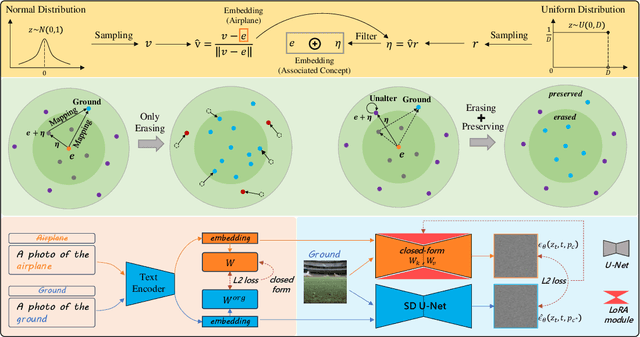
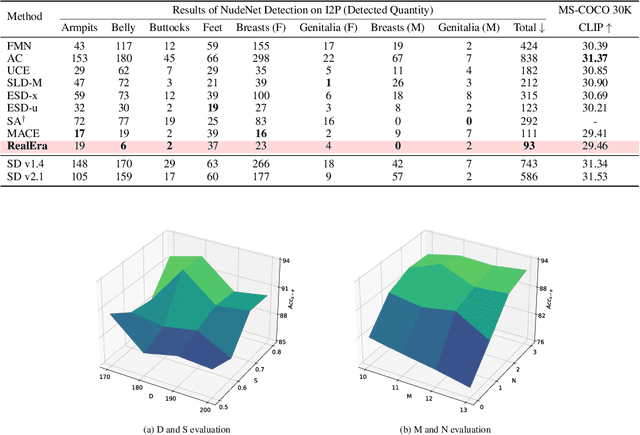
Abstract:The remarkable development of text-to-image generation models has raised notable security concerns, such as the infringement of portrait rights and the generation of inappropriate content. Concept erasure has been proposed to remove the model's knowledge about protected and inappropriate concepts. Although many methods have tried to balance the efficacy (erasing target concepts) and specificity (retaining irrelevant concepts), they can still generate abundant erasure concepts under the steering of semantically related inputs. In this work, we propose RealEra to address this "concept residue" issue. Specifically, we first introduce the mechanism of neighbor-concept mining, digging out the associated concepts by adding random perturbation into the embedding of erasure concept, thus expanding the erasing range and eliminating the generations even through associated concept inputs. Furthermore, to mitigate the negative impact on the generation of irrelevant concepts caused by the expansion of erasure scope, RealEra preserves the specificity through the beyond-concept regularization. This makes irrelevant concepts maintain their corresponding spatial position, thereby preserving their normal generation performance. We also employ the closed-form solution to optimize weights of U-Net for the cross-attention alignment, as well as the prediction noise alignment with the LoRA module. Extensive experiments on multiple benchmarks demonstrate that RealEra outperforms previous concept erasing methods in terms of superior erasing efficacy, specificity, and generality. More details are available on our project page https://realerasing.github.io/RealEra/ .
Prediction Exposes Your Face: Black-box Model Inversion via Prediction Alignment
Jul 11, 2024Abstract:Model inversion (MI) attack reconstructs the private training data of a target model given its output, posing a significant threat to deep learning models and data privacy. On one hand, most of existing MI methods focus on searching for latent codes to represent the target identity, yet this iterative optimization-based scheme consumes a huge number of queries to the target model, making it unrealistic especially in black-box scenario. On the other hand, some training-based methods launch an attack through a single forward inference, whereas failing to directly learn high-level mappings from prediction vectors to images. Addressing these limitations, we propose a novel Prediction-to-Image (P2I) method for black-box MI attack. Specifically, we introduce the Prediction Alignment Encoder to map the target model's output prediction into the latent code of StyleGAN. In this way, prediction vector space can be well aligned with the more disentangled latent space, thus establishing a connection between prediction vectors and the semantic facial features. During the attack phase, we further design the Aligned Ensemble Attack scheme to integrate complementary facial attributes of target identity for better reconstruction. Experimental results show that our method outperforms other SOTAs, e.g.,compared with RLB-MI, our method improves attack accuracy by 8.5% and reduces query numbers by 99% on dataset CelebA.
Disrupting Diffusion: Token-Level Attention Erasure Attack against Diffusion-based Customization
May 31, 2024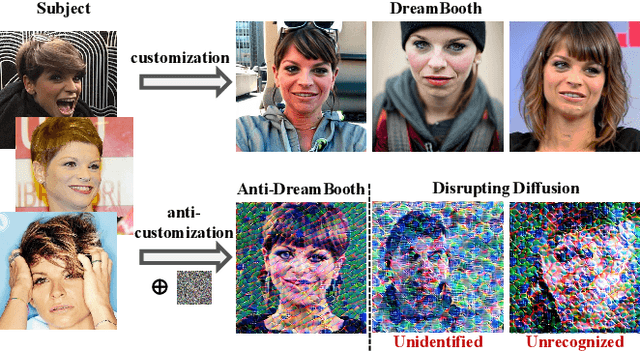
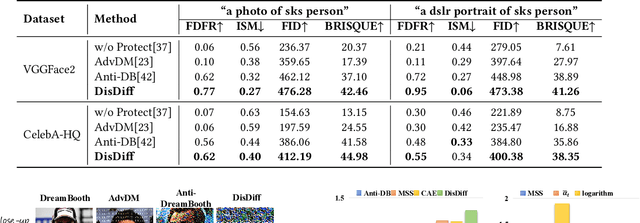
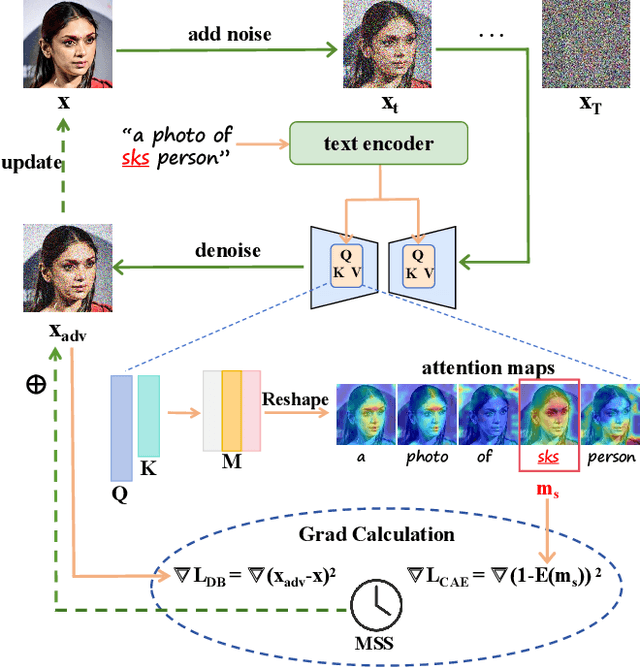
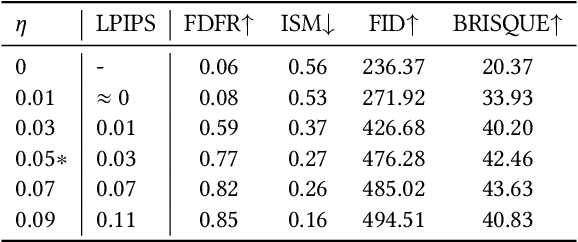
Abstract:With the development of diffusion-based customization methods like DreamBooth, individuals now have access to train the models that can generate their personalized images. Despite the convenience, malicious users have misused these techniques to create fake images, thereby triggering a privacy security crisis. In light of this, proactive adversarial attacks are proposed to protect users against customization. The adversarial examples are trained to distort the customization model's outputs and thus block the misuse. In this paper, we propose DisDiff (Disrupting Diffusion), a novel adversarial attack method to disrupt the diffusion model outputs. We first delve into the intrinsic image-text relationships, well-known as cross-attention, and empirically find that the subject-identifier token plays an important role in guiding image generation. Thus, we propose the Cross-Attention Erasure module to explicitly "erase" the indicated attention maps and disrupt the text guidance. Besides,we analyze the influence of the sampling process of the diffusion model on Projected Gradient Descent (PGD) attack and introduce a novel Merit Sampling Scheduler to adaptively modulate the perturbation updating amplitude in a step-aware manner. Our DisDiff outperforms the state-of-the-art methods by 12.75% of FDFR scores and 7.25% of ISM scores across two facial benchmarks and two commonly used prompts on average.
Digging into Depth Priors for Outdoor Neural Radiance Fields
Aug 08, 2023Abstract:Neural Radiance Fields (NeRF) have demonstrated impressive performance in vision and graphics tasks, such as novel view synthesis and immersive reality. However, the shape-radiance ambiguity of radiance fields remains a challenge, especially in the sparse viewpoints setting. Recent work resorts to integrating depth priors into outdoor NeRF training to alleviate the issue. However, the criteria for selecting depth priors and the relative merits of different priors have not been thoroughly investigated. Moreover, the relative merits of selecting different approaches to use the depth priors is also an unexplored problem. In this paper, we provide a comprehensive study and evaluation of employing depth priors to outdoor neural radiance fields, covering common depth sensing technologies and most application ways. Specifically, we conduct extensive experiments with two representative NeRF methods equipped with four commonly-used depth priors and different depth usages on two widely used outdoor datasets. Our experimental results reveal several interesting findings that can potentially benefit practitioners and researchers in training their NeRF models with depth priors. Project Page: https://cwchenwang.github.io/outdoor-nerf-depth
Joint Plasticity Learning for Camera Incremental Person Re-Identification
Oct 18, 2022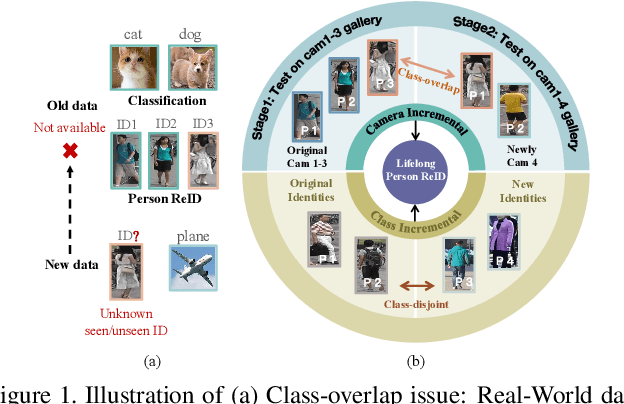

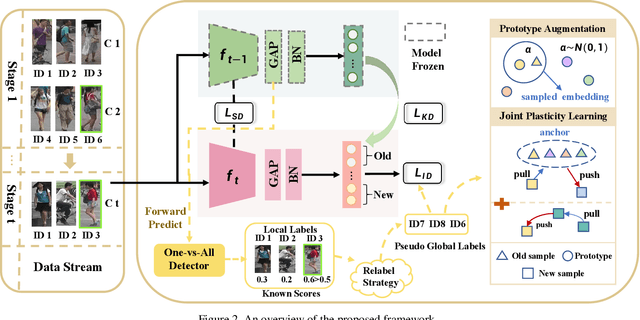

Abstract:Recently, incremental learning for person re-identification receives increasing attention, which is considered a more practical setting in real-world applications. However, the existing works make the strong assumption that the cameras are fixed and the new-emerging data is class-disjoint from previous classes. In this paper, we focus on a new and more practical task, namely Camera Incremental person ReID (CIP-ReID). CIP-ReID requires ReID models to continuously learn informative representations without forgetting the previously learned ones only through the data from newly installed cameras. This is challenging as the new data only have local supervision in new cameras with no access to the old data due to privacy issues, and they may also contain persons seen by previous cameras. To address this problem, we propose a non-exemplar-based framework, named JPL-ReID. JPL-ReID first adopts a one-vs-all detector to discover persons who have been presented in previous cameras. To maintain learned representations, JPL-ReID utilizes a similarity distillation strategy with no previous training data available. Simultaneously, JPL-ReID is capable of learning new knowledge to improve the generalization ability using a Joint Plasticity Learning objective. The comprehensive experimental results on two datasets demonstrate that our proposed method significantly outperforms the comparative methods and can achieve state-of-the-art results with remarkable advantages.
Imagine by Reasoning: A Reasoning-Based Implicit Semantic Data Augmentation for Long-Tailed Classification
Dec 15, 2021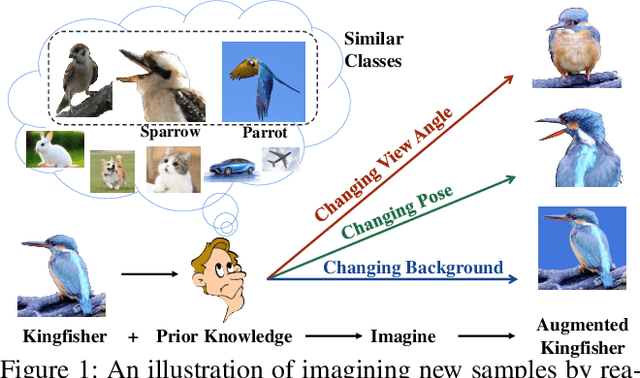
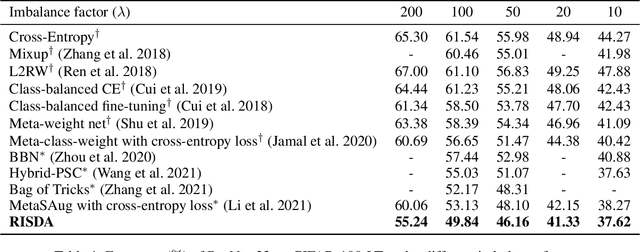


Abstract:Real-world data often follows a long-tailed distribution, which makes the performance of existing classification algorithms degrade heavily. A key issue is that samples in tail categories fail to depict their intra-class diversity. Humans can imagine a sample in new poses, scenes, and view angles with their prior knowledge even if it is the first time to see this category. Inspired by this, we propose a novel reasoning-based implicit semantic data augmentation method to borrow transformation directions from other classes. Since the covariance matrix of each category represents the feature transformation directions, we can sample new directions from similar categories to generate definitely different instances. Specifically, the long-tailed distributed data is first adopted to train a backbone and a classifier. Then, a covariance matrix for each category is estimated, and a knowledge graph is constructed to store the relations of any two categories. Finally, tail samples are adaptively enhanced via propagating information from all the similar categories in the knowledge graph. Experimental results on CIFAR-100-LT, ImageNet-LT, and iNaturalist 2018 have demonstrated the effectiveness of our proposed method compared with the state-of-the-art methods.
Mask is All You Need: Rethinking Mask R-CNN for Dense and Arbitrary-Shaped Scene Text Detection
Sep 08, 2021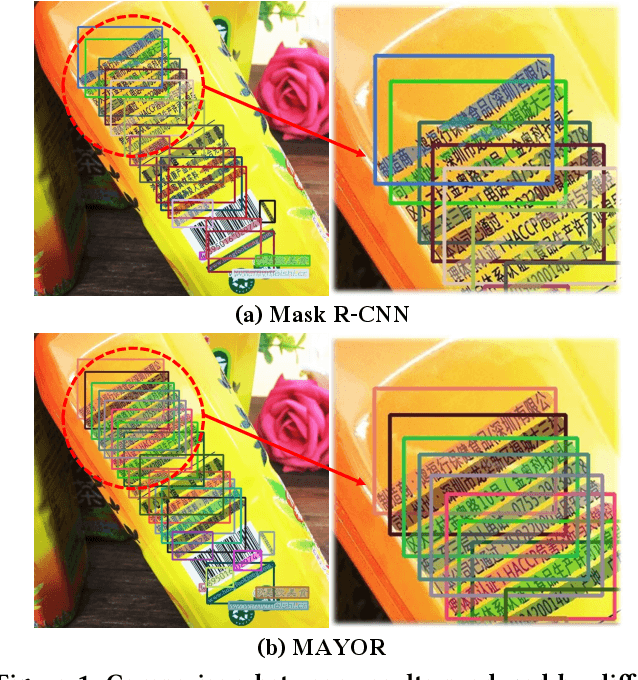
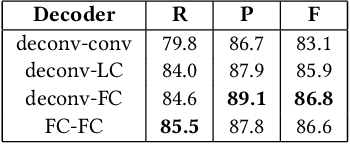
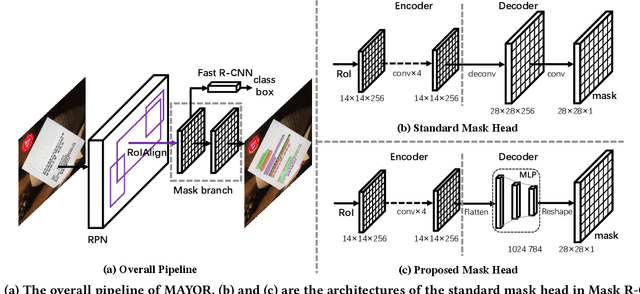
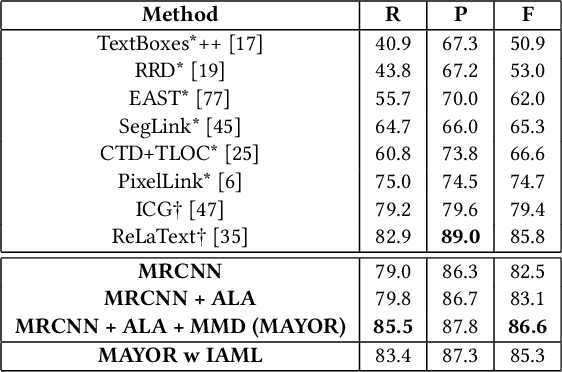
Abstract:Due to the large success in object detection and instance segmentation, Mask R-CNN attracts great attention and is widely adopted as a strong baseline for arbitrary-shaped scene text detection and spotting. However, two issues remain to be settled. The first is dense text case, which is easy to be neglected but quite practical. There may exist multiple instances in one proposal, which makes it difficult for the mask head to distinguish different instances and degrades the performance. In this work, we argue that the performance degradation results from the learning confusion issue in the mask head. We propose to use an MLP decoder instead of the "deconv-conv" decoder in the mask head, which alleviates the issue and promotes robustness significantly. And we propose instance-aware mask learning in which the mask head learns to predict the shape of the whole instance rather than classify each pixel to text or non-text. With instance-aware mask learning, the mask branch can learn separated and compact masks. The second is that due to large variations in scale and aspect ratio, RPN needs complicated anchor settings, making it hard to maintain and transfer across different datasets. To settle this issue, we propose an adaptive label assignment in which all instances especially those with extreme aspect ratios are guaranteed to be associated with enough anchors. Equipped with these components, the proposed method named MAYOR achieves state-of-the-art performance on five benchmarks including DAST1500, MSRA-TD500, ICDAR2015, CTW1500, and Total-Text.
Rescuing Deep Hashing from Dead Bits Problem
Feb 01, 2021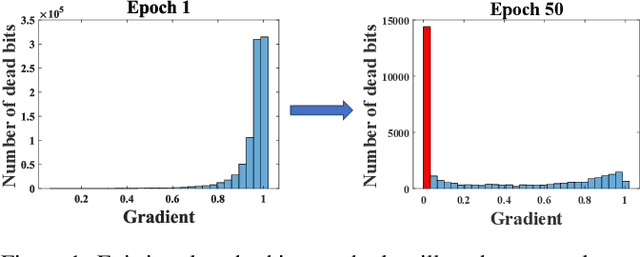
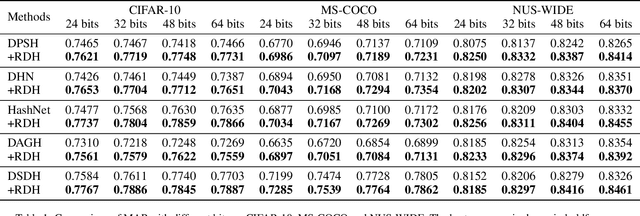
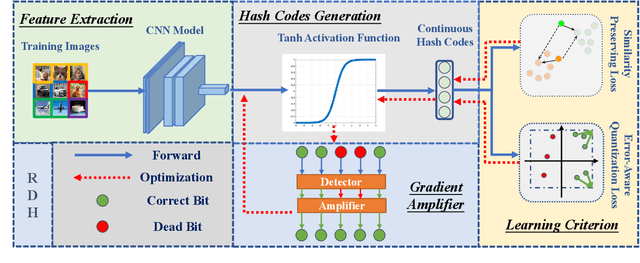
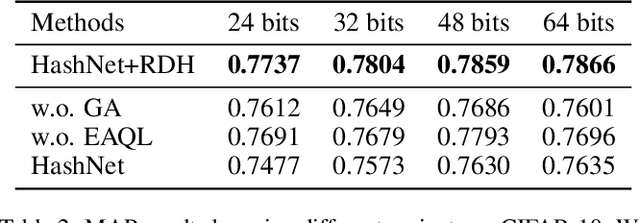
Abstract:Deep hashing methods have shown great retrieval accuracy and efficiency in large-scale image retrieval. How to optimize discrete hash bits is always the focus in deep hashing methods. A common strategy in these methods is to adopt an activation function, e.g. $\operatorname{sigmoid}(\cdot)$ or $\operatorname{tanh}(\cdot)$, and minimize a quantization loss to approximate discrete values. However, this paradigm may make more and more hash bits stuck into the wrong saturated area of the activation functions and never escaped. We call this problem "Dead Bits Problem~(DBP)". Besides, the existing quantization loss will aggravate DBP as well. In this paper, we propose a simple but effective gradient amplifier which acts before activation functions to alleviate DBP. Moreover, we devise an error-aware quantization loss to further alleviate DBP. It avoids the negative effect of quantization loss based on the similarity between two images. The proposed gradient amplifier and error-aware quantization loss are compatible with a variety of deep hashing methods. Experimental results on three datasets demonstrate the efficiency of the proposed gradient amplifier and the error-aware quantization loss.
Exploring Relations in Untrimmed Videos for Self-Supervised Learning
Aug 06, 2020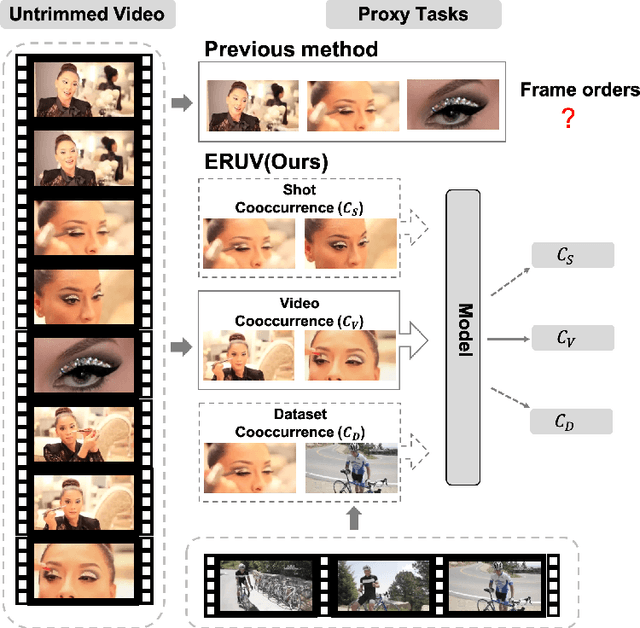
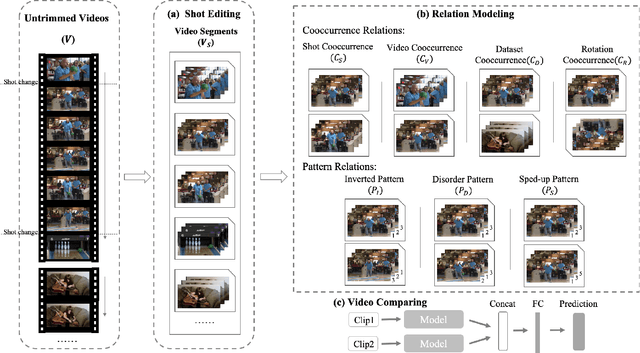
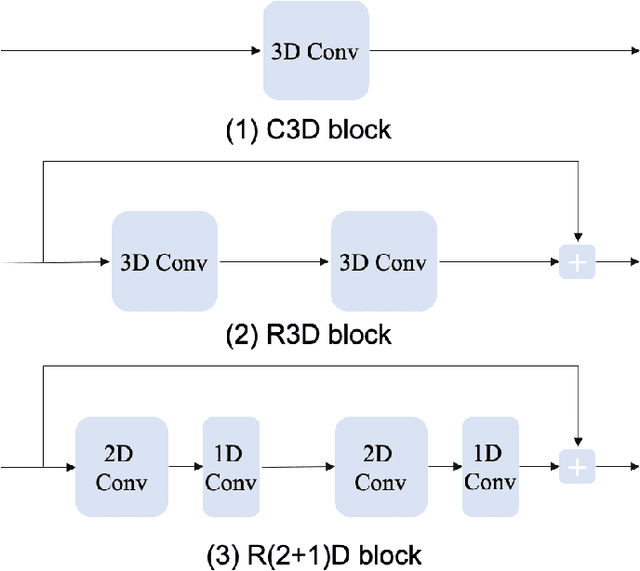
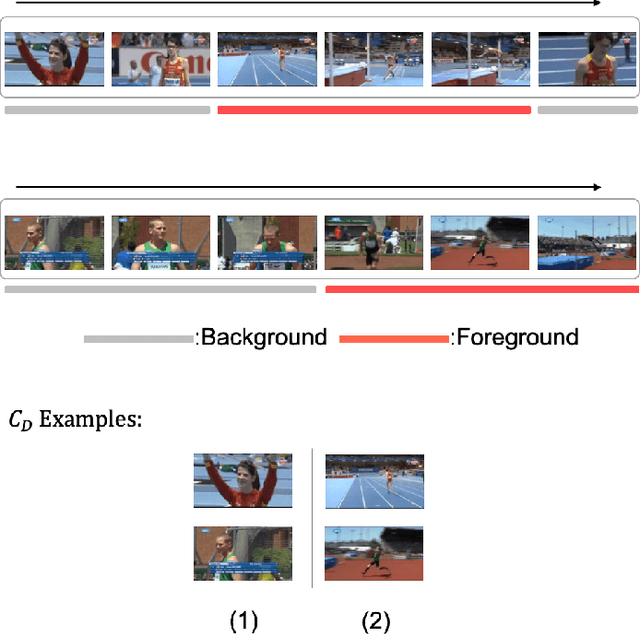
Abstract:Existing video self-supervised learning methods mainly rely on trimmed videos for model training. However, trimmed datasets are manually annotated from untrimmed videos. In this sense, these methods are not really self-supervised. In this paper, we propose a novel self-supervised method, referred to as Exploring Relations in Untrimmed Videos (ERUV), which can be straightforwardly applied to untrimmed videos (real unlabeled) to learn spatio-temporal features. ERUV first generates single-shot videos by shot change detection. Then a designed sampling strategy is used to model relations for video clips. The strategy is saved as our self-supervision signals. Finally, the network learns representations by predicting the category of relations between the video clips. ERUV is able to compare the differences and similarities of videos, which is also an essential procedure for action and video related tasks. We validate our learned models with action recognition and video retrieval tasks with three kinds of 3D CNNs. Experimental results show that ERUV is able to learn richer representations and it outperforms state-of-the-art self-supervised methods with significant margins.
 Add to Chrome
Add to Chrome Add to Firefox
Add to Firefox Add to Edge
Add to Edge